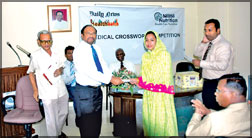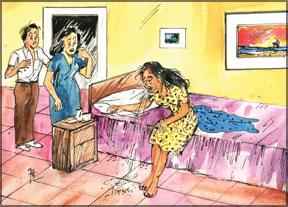|
Healthwatch |
Compiled and coordinated by Edward Arambewala
|
Human induced changes in emerging and re-emerging infections
Dr. Viraj Peramuna
Jhon M. Last Emeritus Professor of Epidemiology and Community
Medicine University of Ottawa in an article on - new causes for new
diseases in pointing out the human factor involved in them says:
"For better or worse, the risk of many infectious diseases is
influenced by human alteration of local, regional, or global
ecosystems".
Global warming
The greenhouse effect, mainly due to fossil fuel combustion, is
changing the world's climate. Mosquitos that carry malaria, yellow
fever, dengue and viral encephalitis are extending their range into
temperate zones, higher altitudes of tropical regions and large cities
like Nairobi and Harare. By the middle of the 21st century there may be
several hundred million more cases of malaria each year, as a result,
many of them in regions now free of malaria.

Not all ecological changes are caused by human activities. The
tropical Pacific Ocean current El Nino undergoes period warming. In the
early 1990s, such a change was accompanied by the proliferation in
coastal waters of South America of blue-green algae. These harbour the
cholera vibrio which can survive for lengthy periods in various forms of
plankton.
Tuberculosis has always flourished in conditions of poverty,
overcrowding, poor nutrition and illiteracy; HIV infection spreads when
women must resort to prostitution in order to survive, and when
intravenous drug abuse with needle-sharing occurs.
Finally, there have been several recent cases of a variant of
Creutzfeld-Jakob diseases, a progressive and fatal degenerative brain
disease, in the United Kingdom and France.
These cases are thought to be due to exposure to an unconventional
infectious agent belonging to the group responsible for transmissible
spongiform encephalopathies (TSE).
One of these, bovine spongiform encephalopathy (BSE) - a disease of
cattle - is thought to be caused by the agent of scrapie, a TSE of
sheep. Sheep's offal has been used to prepare protein supplements fed to
cattle.
Although not yet proven, the circumstantial evidence is persuasive
and worrying: the infectious agent seems to have passed from sheep to
cattle to human beings. This may be an example of the consequences of
human interference with natural processes - in this instance feeding
animal protein to a vegetarian species.
Cleaning up dirty water and keeping it clean
In many parts of the developing world, drinking-water is collected
from sources outside the home. It may be contaminated at the source or
during storage. Strategies to reduce waterborne disease transmission
must safeguard against both possibilities.
New products allow families to disinfect drinking-water immediately
after collection, and newly designed narrow-mouthed, closed storage
vessels prevent recontamination.
This two-component prevention strategy is a practical and inexpensive
way for households and communities that lack safe water to protect
themselves against a variety of waterborne pathogens, and can
progressively decrease waterborne diarrhoeal diseases.
The method has been tested in various parts of Bolivia by the United
States Department of Health, the US Centers for Disease Control and
Prevention, the Pan American Health Organization and the United States
Agency for International Development.
Well accepted, it has significantly improved the quality of stored
water and brought about a decrease in diarrhoeal disease, especially
among infants under one year.
The method could be an effective took against waterborne diseases
such as typhoid fever and cholera in such settings as day care centres
and old people's homes, and could be used during festivals.
Clinics, schools and even street vendors are attractive potential
targets for this intervention, which encourages the washing of hands,
foods and kitchen utensils in order to reduce diseases transmitted by
personal contact or contaminated food.
The next generation of vessels, currently being pilotested among
Guatemalan street vendors, will have a built-in soap dish to promote
hand-washing. With the commitment of communities, ministries of health,
United Nations agencies, non-governmental organizations and private
industry, this low-cost effective intervention could be implemented on a
broader scale.
########################################
Medical Crossword No. 32
Entries from doctors too
We are pleased to note, that more and more doctors too, among other
professionals are now sending entries to our - Healthwatch Medical
Crossword Competition.
|

A section of the prize winners of the Medical Crossward with
their friends at the event. |
In the first batch of entries we received for the Medical Crossword
No. 32 based on the theme - Physical Activity - we had ten entries from
the doctors.
Among them there was one young doctor from Kurunegala Dr. Arjuna
Ellepola (31 yrs) who had sent entry for his wife too - Manori Tharanga
Ellepola. When we spoke to him to find out whether him sending an entry
meant that he found the Medical crossword feature the only such feature
in the English daily newspapers here, one of our own creations in our
health education programme in a daily press, he said "yes, I must
congratulate your Features Department for this innovative approach for
health education of the readers.
|

In our last Healthwatch Medical Crossword Draw No. 31, held
at the Nawaloka Hospital, Colombo Dr. Noel Somasunderam,
special invitee at the event speaking on obesity on right is
Deputy Chairman Navaloka Hospital Jayantha Dharmadasa and
Hospitals Medical Director Prof. Lal Chandrasena. |
As doctors we find it interesting too, as it relates to our
profession, promoting preventive health in an interesting way."
Student Entries
This time we had student entries from 17, 18, 19, 20, 22, 23, 25,
26-year-old from Kandy, Kohuwala, Colombo, Nugegoda, Mattumagala,
Panadura.
|

Prof. Lal Chandrasena, Medical Director Navaloka Hospital
handing over the second prize winner in Crossword No. 30
with her cheque for Rs. 2,000. |
Among them Anupama Siribaddana 17 years, Grade 12, Mahamaya Girls
School, Kandy. Y. Risla 18 yrs G. S. Convent, Colombo. A. F. Kariyapper
22 yrs.
Undergraduate from Kohuwala. A. Dharshika 22 yrs Medical student from
Colombo 6.
From Company Chairman and others
We had entries from a Company Chairman Mr. Joe Aloysius 78 yrs. A
young business analyst Miss Jilsha Tissera 24 yrs from Bambalapitiya.
|

Chief quest at the Crossword Draw Hospital Deputy Chairman
Jayantha Dharmadasa handing over the first prize winner in
Medical Crossword No.30 Mrs. N.Samsudeen with her prize
cheque for Rs. 3,000. |
Attorney-at-Law. An entry from a lawyer Christopher Cadiramanpulle
(71 yrs.) Retired Principal - An entry from a retired school Principal
Rani Fernando 76 yrs.
From 80-year-olds
We had 5 entries upto now from the 80-year-olds. Among them are E.C.
Jayasinghe 82 yrs. from Nugegoda. Rose Samarasinghe also 82 yrs from
Nugegoda. Quintus Jayawardena 84 yrs from Ahangama and R.M.L. Ratnayake
84 years old from Matale.
Entries from Housewives
Among entries from housewives we found a good number from those in
the age group of 70s - 70, 75, 77, 78, 79, and also those in the young
age group of 30s - 34, 35, 38. Our Medical Advisory Panel is compiling
statics of those who are sending entries for the Medical Crossword for a
study.
##################################
Gastrointestinal Decontamination in Poisoning
Prof. Ravindra Fernando, Faculty of Medicine,
Colombo.
Acute poisoning is a medical emergency. Gastrointestinal
decontamination is a commonly practiced measure in the management of
poisoning. This includes any method which aims at reducing the
absorption of an ingested poisonous substance.
Methods of gastrointestinal decontamination include inducing emesis
(vomiting), administering activated charcoal, gastric aspiration and
lavage.

These methods should only be considered following a full medical
assessment by the physician and once the patient's acute condition is
stabilised. It should only be considered in patients who are able to
protect their airway and who have taken a potentially dangerous amount
of a poison. Secretions should be sucked out.
If cyanosed, oxygen must be given. If the respiration is impaired,
intubation and assisted ventilation should be considered.
Patients who are most likely to benefit should have the
decontamination within 2 hours of ingestion of poisons.
Clear evidence for clinical benefit from gastrointestinal
decontamination has not been shown. The best evidence of benefit is from
activated charcoal. Different Methods of Gastrointestinal
Decontamination in Poisoning
Activated Charcoal
Activated charcoal is charcoal that has been treated with oxygen to
open up millions of tiny pores between the carbon atoms. These so-called
activated charcoal particles are widely used to adsorb poisonous
substances.
When certain chemicals pass next to the carbon surface, they attach
to the surface and are trapped. Adsorption of poisons to activated
charcoal can reduce absorption of a wide range of poisons from the
gastro-intestinal tract. The effectiveness of activated charcoal
decreases with time and is greatest if administered within one hour of
ingestion.
This is widely used for poisoning with drugs. It can be effectively
used for pesticides and most other substances where the toxic dose is
relatively small. Some toxic substances not effectively adsorbed by
activated charcoal are acids, alkalis, iron, lithium, alcohols and
glycol.
The dose is 1 g/kg for all ages
For paraquat (a pesticide used in Sri Lanka) poisoning, Fuller's
earth is the adsorbent of choice. Activated charcoal may also be used.
Activated charcoal is contraindicated if the patient's consciousness is
impaired and they are unable to protect their airway.
Multiple-dose activated charcoal (MDAC) therapy (repeated
administration of oral activated charcoal) enhances elimination of
poisons and may reduce absorption of controlled release drugs and
oleander seeds.
Gastric aspiration and lavage
We see this method being used commonly in a lot of hospitals as the
first measure, in all patients coming after ingestion of any poison.
But, gastric lavage should not be routinely used in all patients.
If and when it is done the doctor must take personal care to ensure
that all precautions are noted and complications are prevented by close
care and monitoring by adequately trained staff.
It cannot be overemphasized that there is mounting evidence to doubt
the clinical benefit of gastric lavage. Most comparative studies show it
to be equivalent or inferior to activated charcoal.
To be continued |

